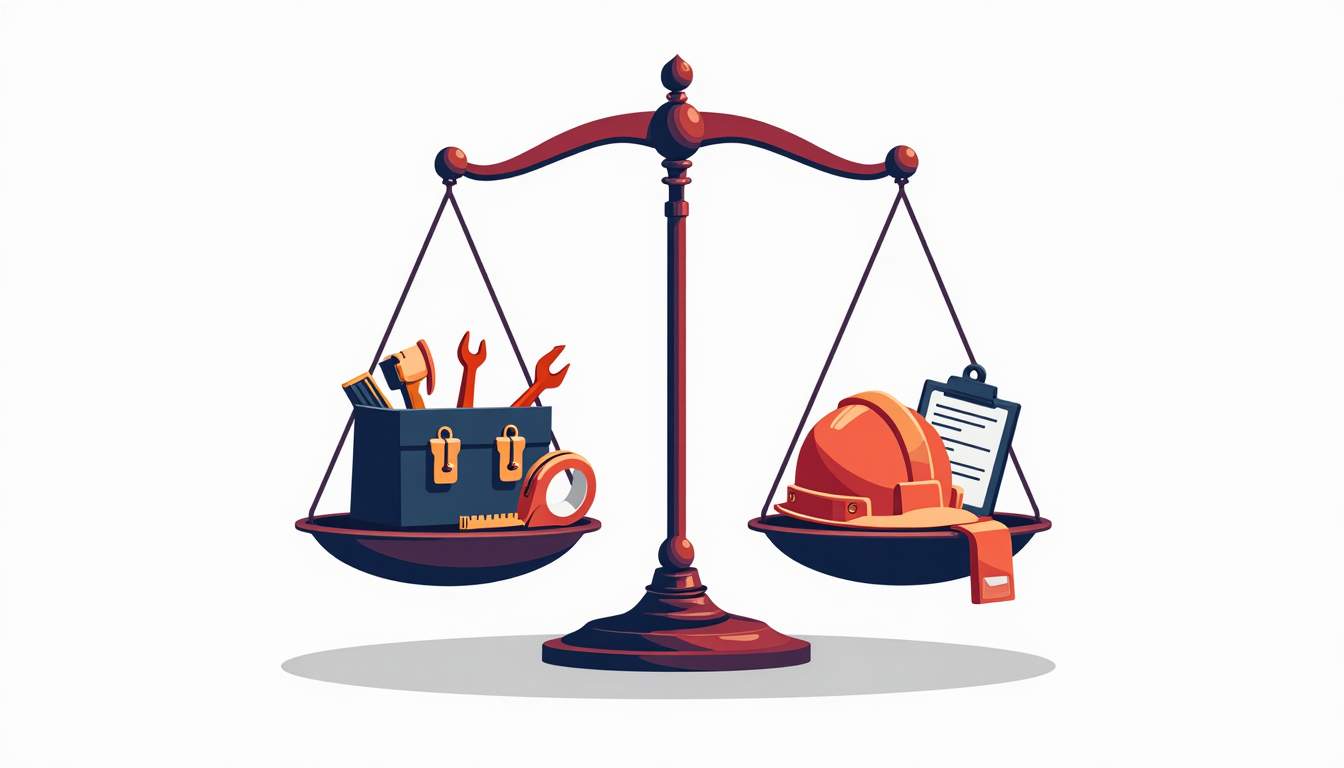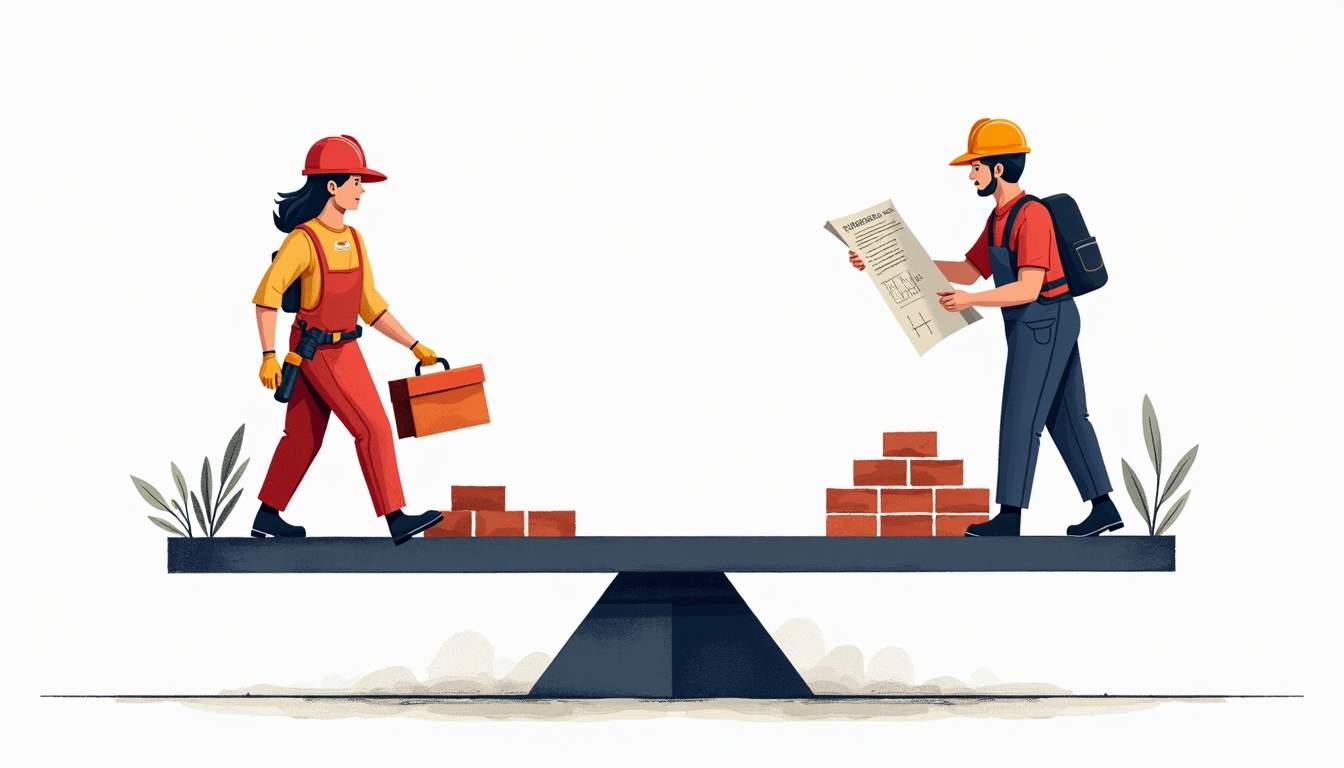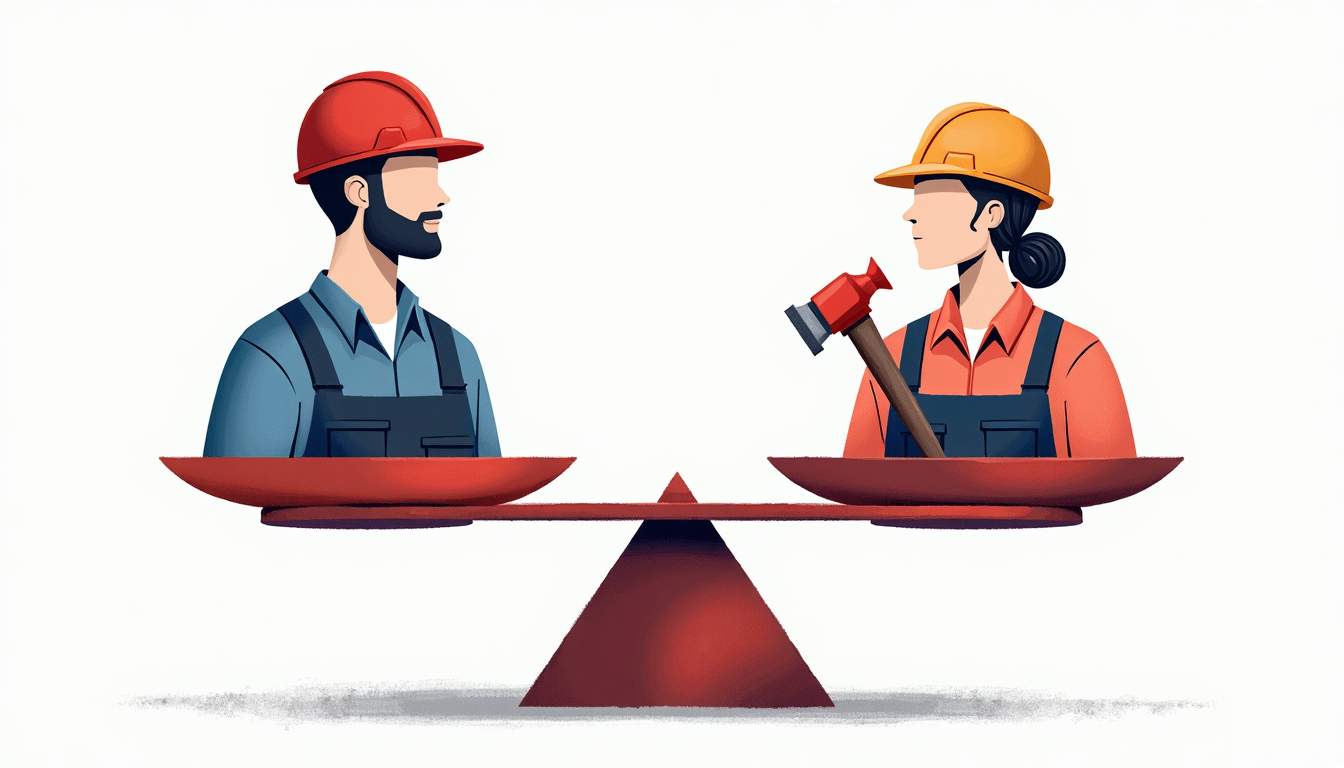In the dynamic world of construction, staffing decisions can make or break a project’s success. Whether you’re managing a multi-million-dollar commercial build or a residential renovation, choosing between temporary and permanent hires is a critical strategic move. Each option carries distinct advantages and challenges that impact timelines, budgets, and overall quality.
With the construction industry projected to grow by over 8% annually through 2028, according to the U.S. Bureau of Labor Statistics, the demand for skilled labor is intensifying. This surge makes understanding the nuances of temporary versus permanent construction hires more important than ever. This article dives deep into the pros and cons of each hiring type, examines real-world examples, and offers actionable insights to help you decide what’s best for your project’s unique needs.
Contents
- 1 Understanding Temporary Construction Hires
- 2 The Case for Permanent Construction Hires
- 3 Key Factors to Consider When Choosing Between Temporary and Permanent Hires
- 4 Real-World Examples: Temporary vs Permanent Hiring in Action
- 5 Best Practices for Managing Temporary and Permanent Construction Workers
- 6 Conclusion: Making the Right Choice for Your Construction Project
Understanding Temporary Construction Hires
What Are Temporary Construction Hires?
Temporary construction hires are workers brought on board for a limited period, often through staffing agencies or labor contractors. These hires are typically project-specific, filling short-term gaps such as peak workload periods, specialized tasks, or urgent labor shortages. Temporary workers can range from general laborers to specialized tradespeople like electricians or welders.

The flexibility of temporary hires allows construction managers to scale their workforce up or down without the long-term commitment or overhead associated with permanent employees. This can be especially valuable in projects with fluctuating labor demands or uncertain timelines. For instance, during the summer months, construction projects may see a surge in activity due to favorable weather conditions, necessitating a larger workforce to meet deadlines. Conversely, during the winter, when work may slow down, companies can reduce their workforce without the complications of layoffs.
Advantages of Temporary Hires in Construction
One of the biggest benefits of temporary construction hires is agility. Projects often face unpredictable challenges—weather delays, supply chain disruptions, or sudden changes in scope—that require rapid workforce adjustments. Temporary hires provide a buffer against these uncertainties. For example, if a critical piece of machinery breaks down and delays production, having a pool of temporary workers ready to step in can help mitigate downtime and keep the project on track.
Cost-effectiveness is another key advantage. Permanent employees come with added expenses such as benefits, insurance, and retirement plans. Temporary workers, on the other hand, are typically paid hourly and managed through agencies that handle payroll taxes and benefits, reducing administrative burdens. This financial flexibility allows construction firms to allocate more resources toward materials or technology upgrades, enhancing overall project quality and efficiency.
Moreover, temporary hires can bring specialized skills for niche tasks without the need for long-term retention. For example, if a project requires advanced concrete finishing for a limited phase, hiring a temporary expert can ensure quality without committing to a permanent salary. This not only ensures that the work is done to the highest standard but also allows the company to maintain a competitive edge by utilizing the latest techniques and technologies available in the industry.
Challenges and Risks of Temporary Construction Workers
Despite their benefits, temporary hires come with certain risks. One common challenge is consistency. Temporary workers might not be as familiar with your company’s safety protocols, equipment, or project specifics, which can lead to inefficiencies or increased accident risk. Training new hires can be time-consuming and may divert attention from project goals, especially if the workforce is constantly changing.
Team cohesion can also suffer. Construction projects thrive on collaboration and communication, and a revolving door of temporary staff can disrupt workflow and morale. Additionally, some temporary workers may lack the motivation or investment in the project’s long-term success compared to permanent employees. This can lead to a fragmented team environment, where trust and rapport are harder to establish, ultimately affecting productivity and job satisfaction among all workers on site.
Finally, there’s the legal and compliance aspect. Misclassification of workers or improper management of temporary staff can expose companies to regulatory penalties. It’s essential to work with reputable staffing agencies and maintain clear contractual agreements. Furthermore, ensuring that temporary workers receive adequate training and understand their rights can help mitigate risks associated with workplace injuries and compliance issues, fostering a safer and more compliant work environment.
The Case for Permanent Construction Hires
Defining Permanent Construction Employees
Permanent construction hires are full-time employees who are integral to your company’s workforce. They typically receive benefits such as health insurance, paid leave, retirement plans, and ongoing training opportunities. These hires represent a long-term investment in your company’s capacity and culture.
Permanent employees often cover core roles essential to maintaining project continuity and quality control. From site supervisors and project managers to skilled tradespeople, these workers form the backbone of your construction operations. Their familiarity with the company’s processes and expectations allows for seamless transitions between projects, minimizing downtime and maximizing efficiency.
Moreover, permanent hires contribute to a cohesive work environment where collaboration flourishes. Their commitment to the organization often translates into a shared vision and collective goals, enhancing overall morale and productivity. This sense of belonging can lead to a more engaged workforce, where employees are motivated to go above and beyond in their roles.
Benefits of Permanent Construction Staff
One of the most compelling advantages of permanent hires is reliability. These workers develop a deep understanding of your company’s standards, safety practices, and project methodologies. This institutional knowledge translates into higher productivity and fewer errors.
Permanent staff also foster stronger team dynamics. Long-term relationships build trust and communication, which are vital for complex construction projects that require coordination across multiple trades and phases. This synergy not only enhances problem-solving capabilities but also cultivates a culture of accountability, where team members feel responsible for one another’s success.
Investing in permanent employees can also improve retention of specialized skills. Training and development programs pay off when workers stay with the company, enhancing overall capability and innovation. As employees gain experience, they can mentor newer team members, creating a robust knowledge-sharing environment that benefits the entire organization.
Drawbacks and Considerations with Permanent Hires
However, permanent hires come with higher fixed costs. Salaries, benefits, and administrative overhead can strain budgets, especially in projects with tight margins or uncertain timelines. Additionally, permanent staff may limit your ability to quickly adjust workforce size in response to project fluctuations. This rigidity can be particularly challenging in an industry where demand can shift rapidly due to economic conditions or seasonal cycles.
Hiring mistakes can be costly. Bringing on a permanent employee who doesn’t fit the company culture or lacks necessary skills can lead to turnover, legal issues, and lost productivity. Therefore, recruitment processes must be thorough and strategic. Implementing robust interview techniques, such as behavioral assessments and practical skill evaluations, can help ensure that new hires align with both the technical requirements of the job and the values of the organization.
Finally, permanent employees may resist changes or new technologies, potentially slowing innovation. Balancing experience with adaptability is crucial in today’s fast-evolving construction landscape. Companies must foster a culture of continuous learning, encouraging employees to embrace new tools and methodologies. This can be achieved through regular training sessions, workshops, and incentivizing participation in industry conferences, ensuring that the workforce remains competitive and forward-thinking.
Key Factors to Consider When Choosing Between Temporary and Permanent Hires
Project Duration and Scope
One of the primary determinants in the hiring decision is the length and complexity of your project. For short-term projects or phases with clearly defined timelines, temporary hires often make sense. They provide the necessary labor without long-term commitments. This flexibility allows companies to scale their workforce up or down as needed, adapting to project demands without the burden of permanent employment costs.
Conversely, for large-scale, multi-year projects, permanent hires can ensure continuity and deeper engagement. These workers become familiar with project intricacies and can help maintain consistent quality throughout. Permanent staff can also foster stronger relationships with clients and stakeholders, as they are more likely to be invested in the project’s success over the long haul. Moreover, having a stable team can enhance collaboration and innovation, as employees build rapport and trust over time.
Budget Constraints and Financial Planning
Budget considerations play a pivotal role. Temporary hires can reduce upfront costs and provide financial flexibility, but hourly rates might be higher than equivalent permanent salaries when factoring in agency fees. Additionally, the unpredictability of project demands can lead to fluctuating costs, making it essential to have a robust financial strategy in place that accommodates these variations.
Permanent hires require a more significant financial commitment but may offer better value over time through increased efficiency and reduced turnover. A detailed cost-benefit analysis tailored to your project’s cash flow and risk tolerance is essential. Furthermore, investing in permanent employees can lead to lower recruitment costs in the long run, as retaining talent reduces the need for frequent hiring cycles and the associated training expenses that come with onboarding new temporary staff.
Skill Requirements and Availability
Assess the skills needed for your project. If specialized expertise is required only briefly, temporary hires can fill gaps effectively. However, if the project demands consistent application of complex skills, permanent hires may be more appropriate. This is particularly relevant in industries where knowledge transfer and skill development are crucial for project success, as permanent employees can be nurtured and trained to meet evolving project needs.
Labor market conditions also influence availability. In tight markets, securing permanent talent might be challenging, making temporary staffing a pragmatic alternative. Additionally, companies may find that temporary hires can bring fresh perspectives and innovative solutions, especially if they come from diverse backgrounds or different industries. This infusion of new ideas can be particularly beneficial in dynamic fields where adaptability and creativity are key to staying competitive.
Regulatory and Safety Considerations
Construction is a high-risk industry with strict safety regulations. Permanent employees are often better integrated into safety programs, reducing workplace accidents and compliance violations. Their ongoing training and familiarity with safety protocols can lead to a more secure work environment, ultimately benefiting both the workers and the organization.
Temporary workers may require additional training and supervision to meet safety standards. Ensuring that temporary hires receive proper onboarding and oversight is critical to mitigating risks. Companies must also consider the implications of liability and insurance when hiring temporary staff, as accidents involving these workers can lead to complex legal challenges. Establishing clear safety guidelines and providing comprehensive training can help bridge the gap between temporary and permanent staff, fostering a culture of safety across the board.
Company Culture and Long-Term Strategy
Consider how your hiring choices align with your company’s culture and growth plans. Permanent employees contribute to building a cohesive culture and institutional memory, which can be a competitive advantage. Their deep understanding of the company’s values and mission can drive engagement and loyalty, fostering a sense of belonging that is often difficult to achieve with temporary staff.
Temporary hires offer flexibility but may not integrate fully into your organizational values. Balancing these factors depends on your strategic priorities and leadership philosophy. It’s essential to create an inclusive environment where temporary workers feel valued and connected to the team, as this can enhance their performance and overall contribution to the project. Initiatives such as team-building activities and open communication channels can help bridge the gap, ensuring that all employees, regardless of their employment status, are aligned with the company’s vision and goals.
Real-World Examples: Temporary vs Permanent Hiring in Action
Case Study 1: Temporary Hires Driving a Commercial Expansion
A regional construction firm faced a sudden surge in demand for commercial retail space. The project required a large, skilled workforce for a six-month build. Rather than committing to permanent hires, the company partnered with a reputable staffing agency to onboard temporary electricians, carpenters, and laborers.

This approach allowed the firm to scale rapidly, manage costs effectively, and maintain flexibility. The project was completed on schedule, and the company avoided long-term payroll obligations once the build was finished. However, they invested heavily in safety training and site supervision to mitigate risks associated with temporary staff. The training sessions not only emphasized safety protocols but also fostered a sense of camaraderie among the temporary workers, which proved beneficial in maintaining morale and productivity on-site. Additionally, the firm implemented a robust feedback system, allowing temporary hires to voice their experiences and suggestions, which ultimately contributed to refining operational processes.
Case Study 2: Permanent Hires Ensuring Quality in Infrastructure Development
A government contractor working on a multi-year highway expansion prioritized permanent hires for key roles, including project managers, heavy equipment operators, and safety officers. This strategy fostered deep expertise and consistent adherence to stringent regulatory standards.
The permanent workforce developed innovative construction techniques that improved efficiency and reduced environmental impact. While initial costs were higher, the long-term benefits in quality and reputation positioned the company for future contracts. Furthermore, the stability provided by permanent employees allowed for the establishment of mentorship programs, where seasoned workers could pass down their knowledge to newer hires. This not only ensured a high standard of work but also cultivated a strong company culture rooted in shared values and commitment to excellence. The contractor’s reputation for quality was further enhanced by their proactive engagement with local communities, showcasing their dedication to sustainable practices and corporate responsibility.
Hybrid Approach: Combining Strengths for Optimal Results
Many construction companies adopt a hybrid model, blending permanent core teams with temporary specialists. This approach leverages the stability and culture of permanent staff while maintaining the flexibility to meet fluctuating demands.
For example, a residential developer might employ permanent site supervisors and skilled tradespeople, supplemented by temporary laborers during peak phases. This balance can optimize costs, quality, and adaptability. The hybrid model also allows for a more dynamic response to project timelines, as the core team can quickly assess when additional temporary support is necessary without compromising the quality of the work. Moreover, this strategy enables companies to build a pipeline of potential permanent hires from their temporary workforce, allowing them to evaluate skills and fit before making long-term commitments. As a result, many firms find that this model not only enhances operational efficiency but also fosters a culture of continuous improvement, where both temporary and permanent staff contribute to the overall success of the projects.
Best Practices for Managing Temporary and Permanent Construction Workers
Effective Onboarding and Training
Regardless of hire type, comprehensive onboarding is essential. Temporary workers should receive the same safety training and project orientation as permanent employees to ensure seamless integration and reduce accidents.
Ongoing training programs for permanent staff keep skills sharp and promote innovation. Investing in workforce development pays dividends in productivity and retention.
Clear Communication and Expectations
Establishing transparent communication channels fosters collaboration and accountability. Temporary workers need clear task assignments and feedback, while permanent employees benefit from involvement in decision-making and continuous improvement initiatives.
Leveraging Technology for Workforce Management
Modern construction management software can streamline scheduling, time tracking, and compliance monitoring for both temporary and permanent workers. These tools enhance visibility and coordination, reducing administrative burdens and errors.
Building Strong Relationships with Staffing Agencies
For companies relying on temporary hires, partnering with reputable staffing agencies is crucial. Agencies that understand your project’s needs and culture can provide better-matched candidates, reducing turnover and improving performance.
Conclusion: Making the Right Choice for Your Construction Project
Deciding between temporary and permanent construction hires is not a one-size-fits-all proposition. It requires a nuanced understanding of your project’s timeline, budget, skill requirements, and long-term goals. Temporary hires offer unmatched flexibility and cost control for short-term or specialized needs, while permanent employees provide stability, expertise, and cultural continuity essential for complex, long-duration projects.

Adopting a strategic, data-driven approach to workforce planning, supported by robust training and management practices, will maximize your project’s success. Whether you opt for temporary, permanent, or a hybrid model, the key lies in aligning your hiring strategy with your project’s unique demands and your company’s vision for growth.
Construction leaders who master this balance position themselves to deliver superior results—on time, on budget, and with uncompromising quality.
Learn how we support construction staffing needs.

Madison Hendrix
Madison has worked in SEO and content writing at Abstrakt for over 5 years and has become a certified lead generation expert through her hours upon hours of research to identify the best possible strategies for companies to grow within our niche industry target audiences. An early adopter of AIO (A.I. Optimization) with many organic search accolades - she brings a unique level of expertise to Abstrakt providing helpful info to all of our core audiences.
- Madison Hendrix#molongui-disabled-link
- Madison Hendrix#molongui-disabled-link
- Madison Hendrix#molongui-disabled-link
- Madison Hendrix#molongui-disabled-link

Michael Carter
Michael Carter is the President of Talent Solutions, an Abstrakt division specializing in corporate recruiting, staffing, and talent acquisition services. With over 12 years at Abstrakt, Michael has played a key role in cultivating top talent and building high-performing teams. His passion for connecting great people with great companies inspired the launch of Talent Solutions, where he leads a dedicated team focused on delivering fast, effective hiring results across industries. Known for his adaptability and hands-on leadership, Michael is committed to helping businesses grow through strategic, people-first recruitment.
- Michael Carter#molongui-disabled-link
- Michael Carter#molongui-disabled-link
- Michael Carter#molongui-disabled-link
- Michael Carter#molongui-disabled-link







